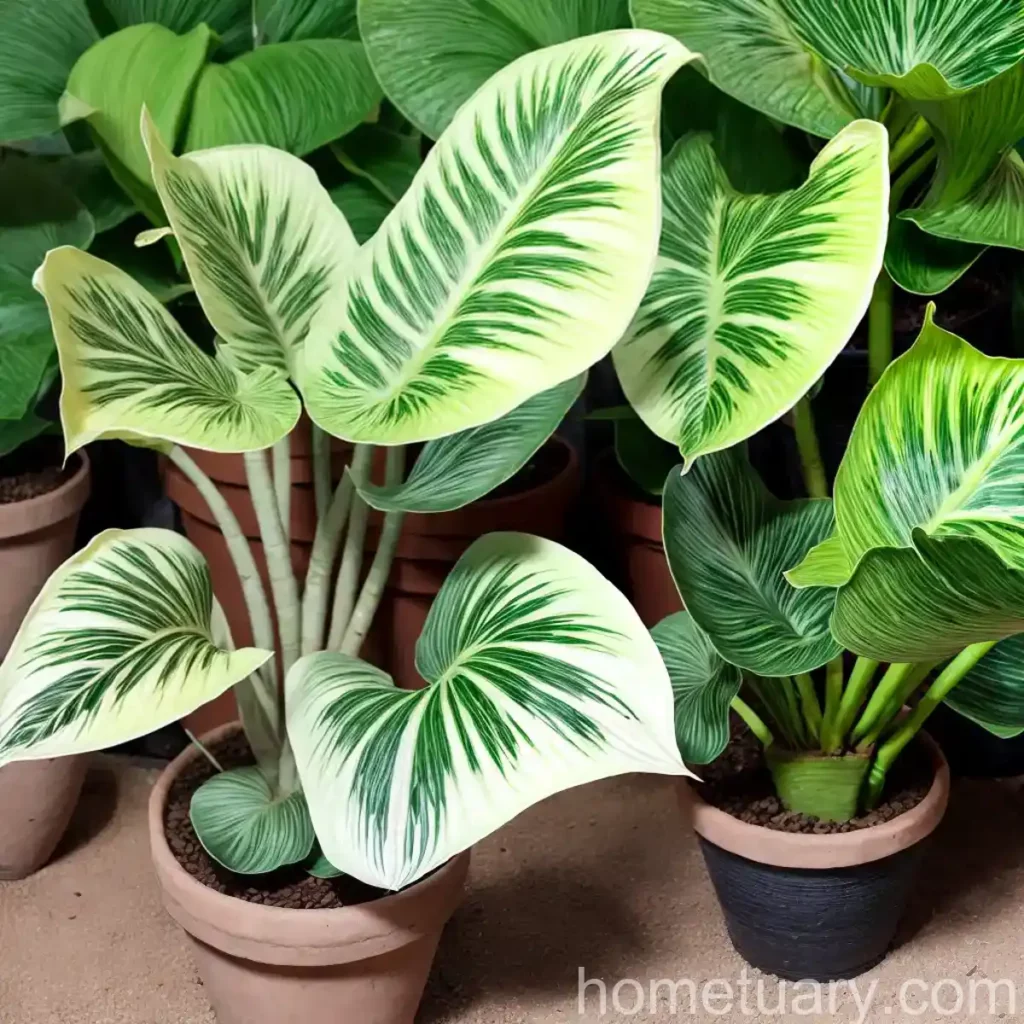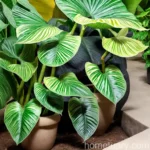Plant Scientist’s Guide to elephant’s ear (Alocasia ‘Frydek’)
Introduction
Plants are fascinating organisms that come in a myriad of shapes, sizes, and forms. They not only contribute to the aesthetic value of our surroundings but also play significant roles in the ecosystem and in human life. In this blog post, we will delve into the captivating world of the elephant’s ear plant known as Alocasia ‘Frydek’.
What is elephant’s ear (Alocasia ‘Frydek’)?
Elephant’s ear (Alocasia ‘Frydek’) is a striking tropical plant that belongs to the Alocasia genus in the Araceae family. The unique feature of Alocasia ‘Frydek’ is its large, arrow-shaped, deep green leaves that are marked with contrasting white or silvery veins. The plant is also known for its prominent upright growth habit, making it an excellent choice for adding a touch of the tropics to indoor spaces.
Key Takeaways – elephant’s ear (Alocasia ‘Frydek’)
- Botanical Name: Alocasia ‘Frydek’
- Common Name: Elephant’s ear
- Genus: Alocasia
- Family: Araceae
- Origin: Southeast Asia
- Water: Consistent moisture
- Sunlight: Bright, indirect light
- Fertilizer: Balanced, water-soluble fertilizer
- Soil: Well-draining, rich potting mix
- Pruning: Removal of damaged leaves
- Propagation: Division or rhizome cuttings
- Container: Suitable for indoor cultivation
- Common Diseases: Fungal leaf spots, crown and root rot
- Common Pests: Spider mites, aphids
- Fun Facts: The plant’s leaves resemble the ears of an elephant, inspiring its common name.
Now, let’s dive deeper into the specific aspects of caring for and understanding elephant’s ear (Alocasia ‘Frydek’).
Culture
Origin and Natural Habitat
Alocasia ‘Frydek’ is native to the tropical and subtropical regions of Southeast Asia, where it thrives in the humid, warm climates of countries such as Thailand, Malaysia, and Indonesia. In its natural habitat, Alocasia ‘Frydek’ typically grows in forest understories, benefiting from the dappled sunlight that filters through the dense canopy.
Uses
- Ornamental Plant: Alocasia ‘Frydek’ is widely sought after for its decorative foliage, making it a popular choice for indoor and outdoor ornamental plantings.
- Indoor Décor: Its striking appearance and relatively compact size make it an ideal indoor plant that adds a touch of exotic charm to living spaces.
Water
Alocasia ‘Frydek’ thrives in consistently moist soil. It is important to keep the soil evenly moist but not waterlogged, as excessive moisture can lead to root rot. When watering, it is best to allow the top inch of the soil to dry before watering again. During the growing season, typically spring and summer, the plant may require more frequent watering compared to the dormant winter months.
Sunlight
Light Requirements: Elephant’s ear plants thrive in bright, indirect light. They should be shielded from direct sunlight, which can scorch their delicate leaves. Placing the plant near an east or north-facing window where it can receive bright, filtered light is ideal.
Fertilizer
Nutrient Needs: Alocasia ‘Frydek’ benefits from regular feeding during the growing season. A balanced, water-soluble fertilizer with an N-P-K ratio of 20-20-20 or similar can be applied every 2-4 weeks during the growing season.
Soil
Soil Type: A well-draining, rich potting mix that retains moisture without becoming waterlogged is ideal for elephant’s ear plants. A mix containing peat, perlite, and organic matter provides the right balance of aeration and moisture retention.
Pruning
Leaf Maintenance: Removal of damaged or yellowing leaves as they appear can help maintain the health and aesthetics of the plant. Pruning should be done with clean, sharp tools to minimize the risk of introducing diseases.
Propagation
Methods: Alocasia ‘Frydek’ can be propagated through division or rhizome cuttings. Dividing the plant during the repotting process or taking rhizome cuttings with at least one growing point are effective propagation methods.
Container Popularity
The compact growth habit and striking appearance of Alocasia ‘Frydek’ make it a popular choice for container gardening. Its suitability for indoor cultivation further enhances its popularity among plant enthusiasts and interior decorators.
Container Common Diseases
- Fungal Leaf Spots: Prolonged periods of high humidity or overwatering can create conditions conducive to the development of fungal leaf spots on Alocasia ‘Frydek’.
- Crown and Root Rot: Excessive moisture in the soil can lead to crown and root rot, adversely affecting the plant’s health.
Disease Diagnosis
Diagnosing diseases in Alocasia ‘Frydek’ involves careful inspection of the plant for symptoms such as discolored or spotted leaves, wilting, or stunted growth. If disease is suspected, it is important to take prompt action to prevent its spread.
Common Pests
- Spider Mites: These tiny pests can infest the undersides of Alocasia ‘Frydek’ leaves, causing stippling and webbing.
- Aphids: Aphids may cluster on the new growth of the plant, sucking sap and causing distortion of the leaves.
Botanist’s Tips
- Humidity: Alocasia ‘Frydek’ benefits from increased humidity, especially when grown indoors. Misting the leaves or using a humidifier can help create the ideal growing environment.
- Rotation: Periodically rotating the plant can ensure even growth and prevent it from leaning towards the light source.
Fun Facts
- The common name “elephant’s ear” is derived from the shape and size of the plant’s leaves, which resemble the large ears of an elephant.
- Alocasia ‘Frydek’ is also known by the names ‘Green Velvet’ and ‘Alocasia micholitziana’.
Now that we have explored the cultural aspects of caring for Alocasia ‘Frydek’, let’s delve into the specific requirements for its growth and maintenance.
Links to External Resources
- Alocasia ‘Frydek’: A Complete Guide
- Growing Elephant’s Ear Plants Indoors
- Alocasia ‘Frydek’ Care Tips
- Tips for Alocasia Plant Care
Conclusion
In conclusion, Alocasia ‘Frydek’, also known as elephant’s ear, is a captivating plant that brings a touch of the tropics to any indoor or outdoor space. Its large, vibrant leaves and relatively low maintenance requirements make it a popular choice among plant enthusiasts and interior decorators.
By understanding its specific cultural needs, such as suitable watering, light, and soil requirements, enthusiasts can ensure the healthy and vibrant growth of Alocasia ‘Frydek’. Additionally, being aware of common diseases and pests that may affect the plant allows for prompt intervention and preventive measures.
Exploring the world of plants, such as Alocasia ‘Frydek’, not only provides an opportunity for plant care and appreciation but also fosters a deeper connection to nature and the remarkable diversity of plant life on our planet.
Through this guide, I hope you have gained valuable insights into the care and cultivation of Alocasia ‘Frydek’ and are inspired to embark on a fulfilling journey of nurturing this magnificent tropical plant.















